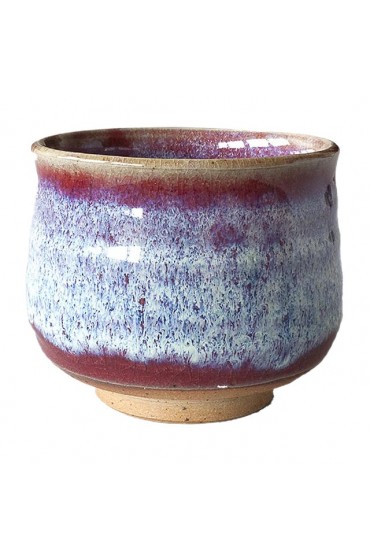Availability: In Stock
Handmade teacup. Stoneware, Oxblood, and Chun glaze (copper red) ''Flambé''. Propane kiln, reduction firing, 1300°C.
Size: height: 8 cm, diameter: 9 cm.
Copper/Iron, Female /male, Yin/Yang, Venus/Mars. Big archetypes in a small cup.
The glaze is one of the most difficult to manage in high fire pottery: it is called Oxblood (Shinsha in Japanese, Sang de boeuf in french). It is a “copper-red glaze”.
The oxide that produces the color is copper. The cups have been fired in reduction (that means there is no oxygen in the kiln during firing).
Copper is usually green, but if fired in reduction can become red. Why? during a reduction firing the flames, that need oxygen to keep alive, try to “survive” at any cost, and ''steal'' oxygen from the pots that are in the kiln. By doing this the flames change the chemistry of clays and glaze present in the kiln. Losing an atom of oxygen, the copper oxide present in the glaze changes its color from green to red.
An only very little amount of copper (0,3 -0-5% of the glaze) can give such bright reds.
In a reduction firing, not all the parts of the kiln atmosphere are without oxygen. Some oxygen-rich clouds still remain. So if a pot is placed partly in an oxygen-rich atmosphere and partly in an oxygen-reduced atmosphere comes with two colors: transparent where there are oxygen and red where there isn’t.
These color changes are completely unpredictable and out of the control of the potter. that’s why copper red glazes are so prized.
The copper red glaze is a Chinese traditional glaze that was later acquired in also in Japan. It was very popular in China in the 15th century. In Europe, these bright red glazes were very prized, and many attempts to reproduced it were made, but without success. The potters in Europe, in fact, couldn't fire at such high temperatures and didn’t know the technique of reduction firing. The first successful attempt was done in France in the late 19th century.
Some of the cups have been thrown with stoneware that includes iron reach particles (black dots visible in the cup’s foot). Because of this iron particles the transparent part of the glaze, that look usually almost colorless (0,3% of copper is not enough to color the glaze) can change their color to light green. So, as always happens, the color of the glaze is the result of the interaction of the clay by which the cup is made and the glaze. In this case, the iron of the clay “migrates” in the glaze. if fired in reduction small amounts of iron can give aqua-green colors, like the famous celadon glaze which is, in fact, an iron green glaze).
The second glaze is a Chun. A Chun is an iron-rich glaze. Iron behaves in the opposite way compared to Copper. In Oxidation, it gives reds, in reduction green/blue tones.
Copper/Iron, Female /male, Yin/Yang, Venus/Mars. Big archetypes in a small cup.
I hope you will enjoy it.
Powered By thatfilmstewpodcast.com © 2024












